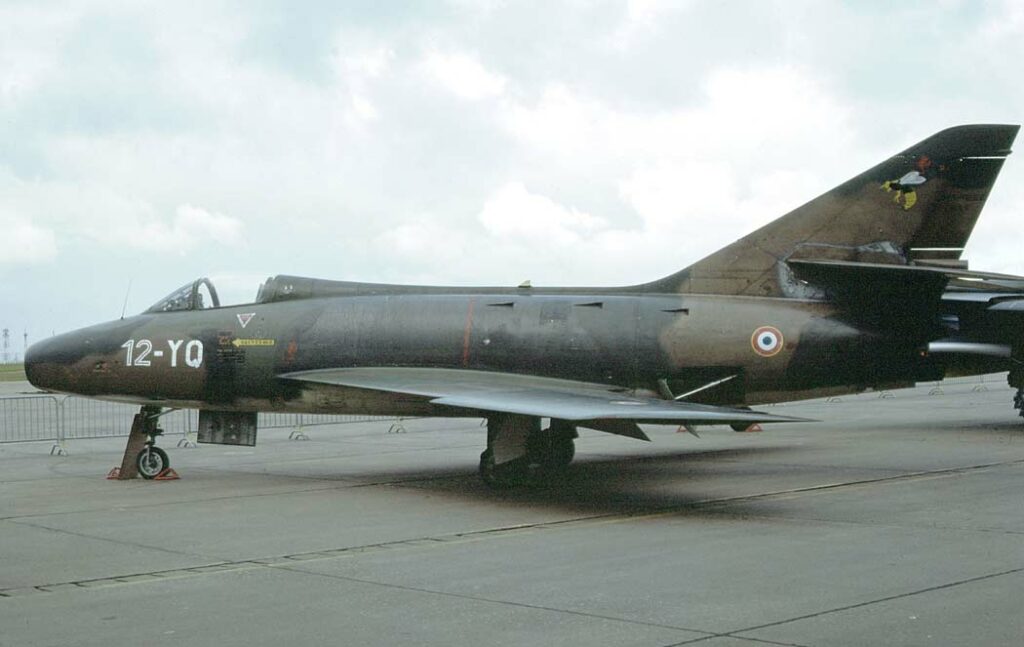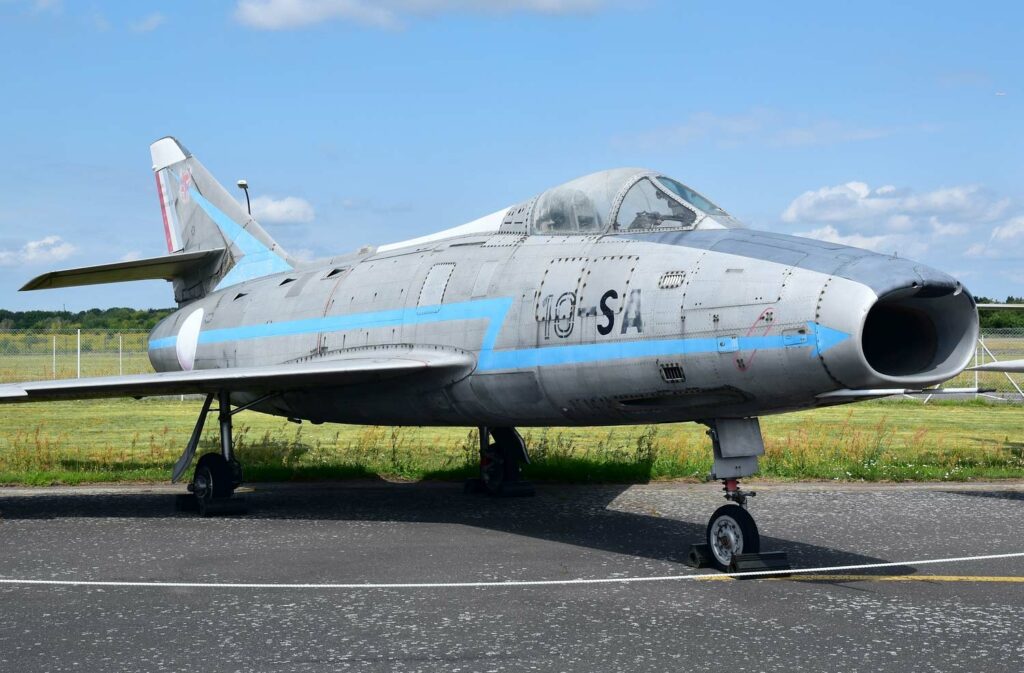The Dassault Super Mystère was France’s first supersonic fighter, featuring a swept-wing design, afterburning engine, and advanced avionics for its era.
Technical Summary
The Dassault Super Mystère was a landmark in aviation history as France’s first aircraft capable of achieving supersonic speeds in level flight. Introduced in the late 1950s, it represented the pinnacle of jet fighter technology at the time, incorporating a swept-wing design, an afterburning turbojet engine, and cutting-edge avionics. The aircraft was powered by a SNECMA Atar 101G engine, enabling it to reach speeds of Mach 1.12. With a maximum takeoff weight of approximately 15,000 kg and a length of 14.13 meters, the Super Mystère was both compact and powerful. Its armament included cannons and a variety of air-to-air and air-to-ground ordnance, making it a versatile platform for both air superiority and ground-attack missions. Despite its advancements, the Super Mystère’s operational life was relatively short, as rapidly evolving technology soon outpaced its capabilities.
The Dassault Super Mystère holds a significant place in the annals of military aviation as France’s first supersonic fighter. This groundbreaking aircraft underscored France’s post-war commitment to reclaiming its status as a leading aerospace power. Developed by Dassault Aviation, the Super Mystère was the culmination of a series of design improvements that began with the Mystère series of fighters.

History of the Development of the Dassault Super Mystère
In the aftermath of World War II, the global aviation community embarked on a quest to break the sound barrier and achieve supersonic flight. France, keen to establish its technological independence and bolster its defense capabilities, embarked on the development of a new class of fighter aircraft. The Super Mystère was the result of this ambition, representing the fourth generation of Dassault’s successful Mystère series.
The development program for the Super Mystère was launched in the early 1950s by Dassault Aviation, led by the visionary Marcel Dassault. The objective was clear: to create a fighter aircraft capable of supersonic speeds, superior maneuverability, and effective engagement capabilities in both air-to-air and air-to-ground missions. The first prototype of the Super Mystère, designated as Super Mystère B1, took to the skies on March 2, 1955, marking a significant milestone in French aviation history.
The Super Mystère did not have a specific NATO nickname, as was common with many aircraft of the era. Its development was a testament to France’s growing prowess in aerospace engineering and its determination to maintain a competitive edge in military aviation.
Design of the Dassault Super Mystère
The design of the Super Mystère incorporated several innovative features that were critical to its performance. The aircraft was characterized by its swept-wing configuration, optimized for high-speed flight. The wings had a sweep angle of 45 degrees, reducing drag and allowing the aircraft to easily surpass the speed of sound. The Super Mystère’s fuselage was streamlined and included an afterburning SNECMA Atar 101G turbojet engine, which provided the thrust necessary for supersonic performance.
One of the key design features was the incorporation of an adjustable-incidence tailplane, which improved stability and control at high speeds. The aircraft was also among the first to utilize an all-moving tail, enhancing its maneuverability. In terms of armament, the Super Mystère was equipped with two 30 mm DEFA cannons mounted in the lower fuselage and had provisions for carrying rockets, bombs, and later, air-to-air missiles, making it a formidable platform for a variety of mission profiles.
However, the Super Mystère’s design also had its drawbacks. While it was state-of-the-art at the time of its introduction, the rapid advancements in aviation technology soon rendered some of its features obsolete. Additionally, its range and payload capacity were limited compared to newer designs that emerged in the 1960s.
Performance of the Dassault Super Mystère
The Super Mystère’s performance metrics were impressive for its time. It could reach a top speed of Mach 1.12 (approximately 1,150 km/h or 715 mph) at altitude, with a service ceiling of 17,000 meters (55,775 feet). The aircraft’s range was approximately 870 kilometers (540 miles) on internal fuel, which could be extended with external drop tanks.
When compared to its contemporaries, such as the American F-100 Super Sabre or the Soviet MiG-19, the Super Mystère was competitive, offering a balance of speed, agility, and firepower. However, it was soon eclipsed by more advanced designs that offered better performance, such as the F-104 Starfighter and the MiG-21.
Variants of the Dassault Super Mystère
The Super Mystère was produced in several variants, with the most notable being the Super Mystère B2. This version featured an improved Atar 101G-3 engine and enhanced avionics. A reconnaissance variant, known as the Super Mystère B4, was also developed but saw limited production. Each variant was tailored to meet specific operational requirements, with improvements in engine performance, armament, and mission capabilities.

Military Use and Combat of the Dassault Super Mystère
The Super Mystère saw extensive service with the French Air Force and was also exported to several countries, including Israel, which used the aircraft effectively in combat during the Six-Day War of 1967 and the Yom Kippur War of 1973. In Israeli service, the Super Mystère conducted air superiority missions and ground-attack operations, proving its versatility and effectiveness in combat. Its armament was utilized to its full potential, engaging enemy aircraft and providing close air support to ground forces.
Despite its successes, the Super Mystère faced competition from more advanced aircraft, leading to its gradual retirement from frontline service. By the late 1970s, most operators had phased out the Super Mystère in favor of newer, more capable fighters.
The Dassault Super Mystère represented a significant leap forward in the development of supersonic fighter aircraft. As France’s first supersonic fighter, it played a crucial role in transitioning air forces into the supersonic era, offering a combination of speed, agility, and firepower that was unparalleled at the time of its introduction. Despite being surpassed by later designs, the Super Mystère’s legacy as a pioneering supersonic fighter remains a testament to the ingenuity and innovation of Dassault Aviation and the broader aerospace community of its era.
Back to the Fighter Jet section.